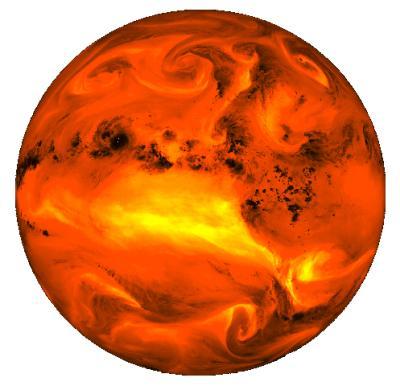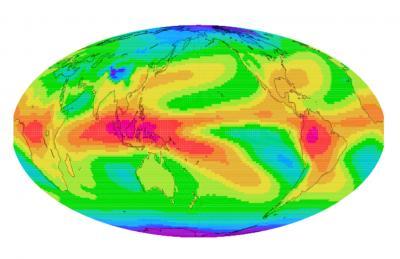Though many people believe that CO2 is the most abundant greenhouse gas in the atmosphere, that honor actually goes to water vapor. NASA has been saying for years that water vapor is the biggest amplifier in global warming, perhaps double the effect of CO2, and a new study from scientists at the University of Miami confirms rising levels of water vapor in the upper troposphere will intensify climate change impacts over the next decades.
Greenhouse gases raise temperatures by trapping the Earth's radiant heat inside the atmosphere. This warming also increases the accumulation of atmospheric water vapor, the most abundant greenhouse gas. The atmospheric moistening traps additional radiant heat and further increases temperatures.

A color enhanced satellite image of upper tropospheric water vapor. Credit: NASA
To investigate the potential causes of a 30-year moistening trend in the upper troposphere, a region 3-7 miles above Earth's surface, the team measured water vapor in the upper troposphere collected by NOAA satellites and compared them to climate model predictions of water circulation between the ocean and atmosphere to determine whether observed changes in atmospheric water vapor could be explained by natural or man-made causes.
Climate models predict that as the climate warms from the burning of fossil fuels, the concentrations of water vapor will also increase in response to that warming. This moistening of the atmosphere, in turn, absorbs more heat and further raises the Earth's temperature.

An illustration of annual mean T2-T12 field that provides a direct measure of the upper-tropospheric water vapor. Purple = dry and Red = moist. Credit: Eui-Seok Chung, Ph.D. Assistant Scientist - UM Rosenstiel School of Marine and Atmospheric Science
Using a set of climate model experiments, the researchers found that rising water vapor in the upper troposphere cannot be explained by natural forces, such as volcanoes and changes in solar activity, but can be explained by increased greenhouse gases, such as CO2.
The new study is the first to show that increased water vapor concentrations in the atmosphere are a direct result of human activities, says Brian Soden, professor of atmospheric sciences at the UM Rosenstiel School and co-author of the study.






Comments